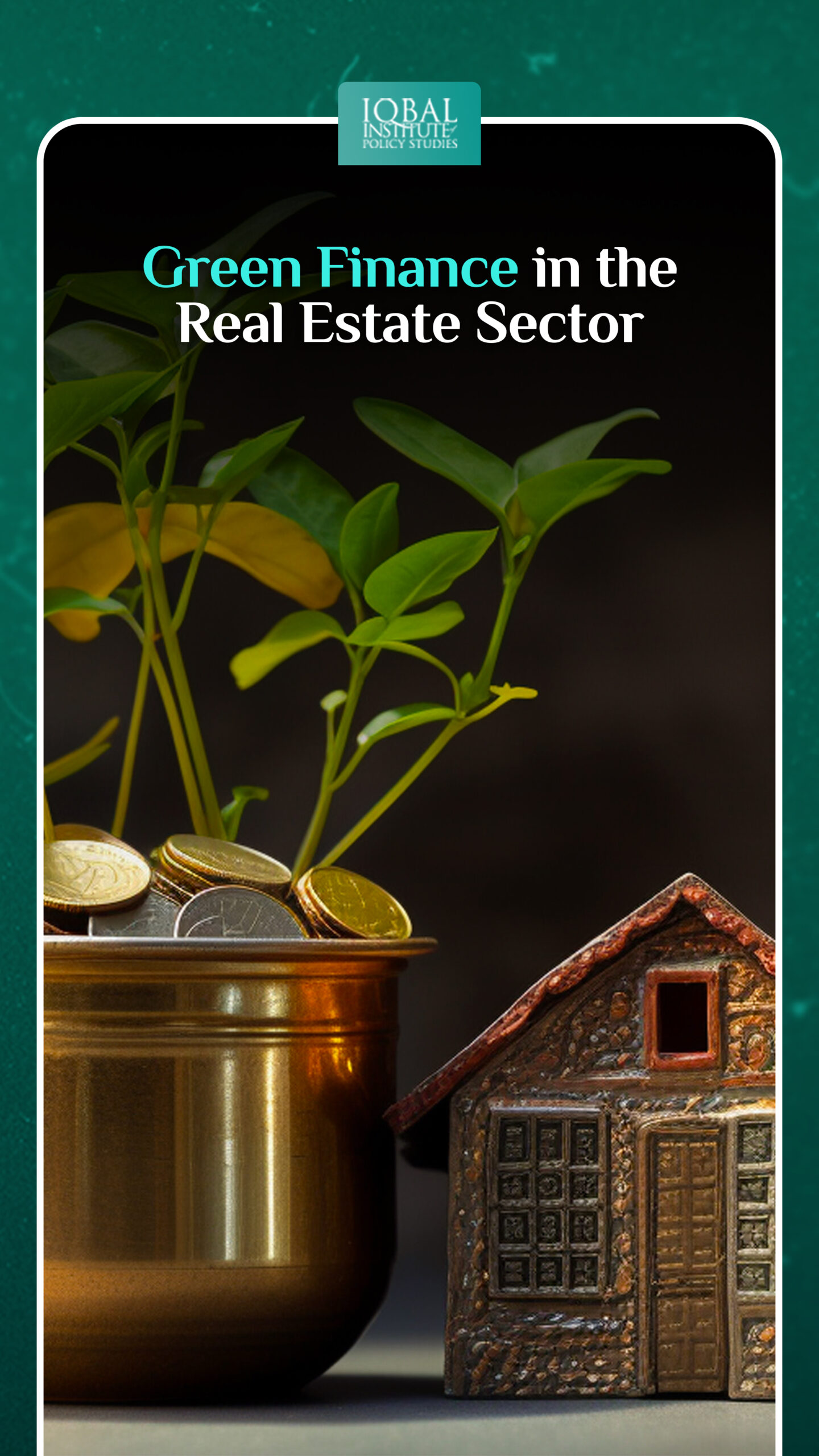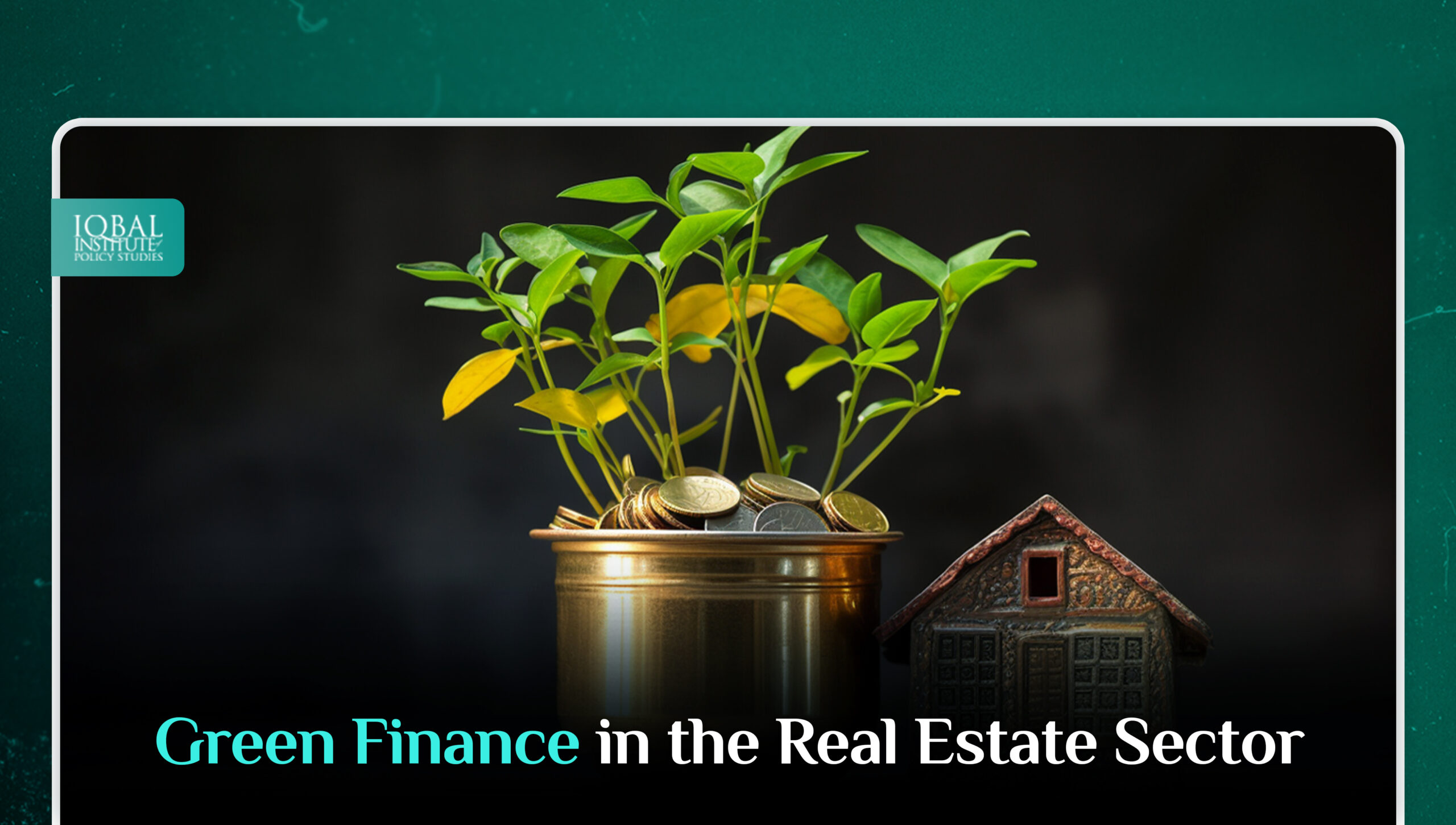Going green is the new norm. The real estate industry has not been forsaken by this global trend as well. As a result of drastic changes in climate conditions, Environmental, Social and Governance (ESG) considerations are becoming more and more relevant in the real estate industry. Thus, many real estate investors and businesses are looking towards green finance- a financial investment in sustainability projects and initiatives. Operations in the real estate sector are a part of a larger drive in the finance realm resulting in its significant growth. However, the acceptability and growth in green finance require work in two domains, i.e. creating a conducive environment for mobilising capital for financing climate-friendly projects and firms and developing environment-friendly innovative financial instruments. Moreover, decarbonisation standards and mechanisms are still being developed by green real estate finance markets, especially in developing countries. Therefore, the real estate industry will need to recognise the long-term social and economic value of green finance to create value in today’s world.
What is Green Financing?
Green Financing is a loan or investment that supports environmentally friendly activities, such as acquiring eco-friendly products and services or developing green infrastructure. This ensures a better and more sustainable environmental outcome.
What are the types of Green Financing?
Green Mortgages
It enables real estate lenders to offer better terms to home buyers who purchase properties with a high environmental sustainability rating or who agree to invest in improving a property’s environmental performance.
Green Loans
These loans serve to fund environmental projects like home solar panels, electric vehicles, energy conservation initiatives, and more.
Green Banks
Like traditional banks, green banks in the real estate sector use public funds to encourage private investment in renewable energy and other environmentally friendly projects. A 2020 study found that between 2011 and 2020, there were 20 green banks in the US investing $7 billion in renewable energy (American Green Bank Consortium, 2021).
Green Bonds
Green bonds function similarly to regular bonds, with one key difference: the funds raised from investors are solely used to fund projects with a positive environmental impact, such as renewable energy and green buildings. For example, in 2017, France used a green bond to borrow 7 billion euros to support clean energy projects (World Economic Forum, 2019).
What are the Benefits?
Encourages sustainability in technology and infrastructure
Green Finance promotes the development of environmentally friendly infrastructure and the diffusion of innovative technologies. As a result, infrastructure is being built by governments in developing nations to enhance long-term resource management, boost national competitiveness and direct private-sector funding toward regional green markets.
Enhances Businesses
Acute shifts in climate change have made real estate investors more concerned about environmental sustainability and its protection. For instance, 82% of reporting asset owners incorporated ESG factors into their selection, appointment, and monitoring processes in 2021, with notable improvements across alternative asset classes such as farmland and infrastructure (PRI, 2021). As a result, real estate companies are transitioning into green real estate businesses. By increasing and publicising their participation in green financing, businesses can raise the value of their portfolio. It gives businesses a competitive edge in the green market, luring in more environmentally conscious investors and clients.
Contributes towards Economic Growth
Governments that support green finance help to safeguard their societies from resource scarcity. To achieve this, they create and support regional renewable energy markets and venture into untapped markets with significant employment potential. For example, China’s green finance policy encourages private investment in green sectors to support a low-carbon transformation for its economy, with policy incentives such as a green development fund (World Economic Forum, 2019).
Gives a Competitive Advantage
A low-carbon green development may unavoidably change from a voluntary to an imperative strategy in response to mounting threats from climate change and other environmental and economic issues. Thus, expanding green financing will give countries and real estate businesses a competitive advantage when environmental regulations tighten.
Environmental Friendly
The annual energy consumption of the real estate sector is 40% of the total global energy and accounts for approximately 20% of greenhouse gas emissions worldwide (Graana Blog, 2022). Most of the emissions that investors produce are financed by loans, investments, and other financial activities. Also, funded emissions contribute 700 times more to financial organisations’ carbon footprint than operational emissions (CDP, April). However, green financing for investments, loans, and credit cards has the potential to reduce emissions.
The Need for Green Financing in the Real Estate Sector of Pakistan
Despite contributing only 0.9% of global greenhouse gas (GHG) emissions, Pakistan is one of the most vulnerable countries to the effects of climate change (Government of Pakistan, 2021). The real estate industry is the second largest industry in the country, putting a significant strain on natural resources. Illegal housing schemes, horizontal development, and expansion of cities are converting green belts, croplands, and forests into a concrete jungles. As a result, the land surface temperature is rising. While Pakistan has experienced a 0.76 0C rise in temperature on average, temperature increases in some regions have been greater than the national and global averages (Government of Pakistan, 2021). Moreover, a 2018 report estimated that globally, 35% of Real Estate Investment Trusts (REIT) properties are vulnerable to climate hazards, of which 17% of properties are exposed to inland flood risk, 6% to sea level rise and coastal floods, and 12% to hurricanes or typhoons (King, 2018).
Furthermore, mega construction projects that lack green building standards, green supply chain methods, green cement and brick manufacturing technology, and green financing incentives put projects like ‘Billion Tree Tsunami’ at risk of losing their environmental impact. Also, Pakistan has had very limited access to international climate and green finance flows. The Government of Pakistan (GoP) plans to reduce greenhouse gas emissions to 50% by 2030 (Mako, Nabi, Mahmood, & Khan, 2022). One way of achieving this objective is via green finance by adopting intelligent policies and collaborating with international organisations that foster green finance projects in all socio-economic sectors, encourage green practices and ensure sustainability.
The Way Forward
Short-Term Reforms
Convene efforts at the national and international levels to develop green finance typologies and standards that are consistent with policy objectives.
Promote transparency and consistency in financial datasets.
Integrate existing ESG criteria into investing decisions.
Increase awareness of the need to integrate green finance into socio-economic sectors.
Mid-Term Reforms
Link bottom-up approach on green finance with top-down research.
Develop new regulations for banking, bonds, and institutional investors.
Integrate data on green revenue share per company into decision-making.
Advocate for better data on green activities at the company level by building green revenue share data into corporate reporting procedures, for example, developing new services for clients supplying or demanding green finance data.
Green financing opportunities can be synergised with other projects such as CPEC and Gwadar city.
Conclusion
Sustainability and a green economy are not something new. As a result, the development and tracking of green finance activities are gaining momentum. However, widespread adoption of this trend is lagging in the real estate sector of Pakistan. The government needs to introduce sustainability and green practices in all socio-economic sectors by utilising green finance in its future projects. Green finance is the life-saving medicine urgently required by our ailing economy and climate change-prone country.
This article is written by Haneen Gul. Haneen is a Research Analyst at the Iqbal Institute of Policy Studies (IIPS).
References
American Green Bank Consortium. (2021). GREEN BANKS IN THE UNITED STATES:2021 U.S. Green Bank Annual Industry Report With Data from Calendar Year 2020. American Green Bank Consortium. Retrieved from https://dcgreenbank.com/wp-content/uploads/2021/05/2021AnnualIndustryReportFinal.pdf
CDP. (April, 28 2021). Finance sector’s funded emissions over 700 times greater than its own. Retrieved from https://www.cdp.net/en/articles/media/finance-sectors-funded-emissions-over-700-times-greater-than-its-own
EMERITUS. (2023, january 29). How Does Green Finance Benefit Organizations and the World. Retrieved from https://emeritus.org/blog/finance-what-is-green-finance/#:~:text=They%20allow%20lenders%20to%20provide,environmental%20performance%20of%20a%20property.
Government of Pakistan. (2021). Pakistan: Updated Natioanlly Determined Contributions 2021. New York: UN Framework Convention on Climate Change. Retrieved from https://unfccc.int/sites/default/files/NDC/2022-06/Pakistan%20Updated%20NDC%202021.pdf
Graana Blog. (2022, Febuary 14). Retrieved from graana.com: graana.com/blog/importance-of-environmental-impact-assessment-in-real-estate/#:~:text=Real%20estate%20is%20the%20second,of%20greenhouse%20gas%20emissions%20worldwide.
King, O. (2018, October 17). GEOPHY. Retrieved from https://geophy.com/insights/climate-risk-real-estate-and-the-bottom-line/
Mako, W. P., Nabi, I., Mahmood, A., & Khan, S. (2022, May). Recent Developments in Climate Finance: Implications for Pakistan. IGC.
PRI. (2021). Retrieved from Principles for Responsible Investment : https://www.unpri.org/annual-report-2021/delivering-our-blueprint-for-responsible-investment/responsible-investors/empower-asset-owners
World Bank. (2016). Green Finance A Bottom-up Approach to Track Existing Flows. International Financial Corportaion. Retrieved from https://documents1.worldbank.org/curated/en/148291573020848322/pdf/Executive-Summary.pdf
World Economic Forum. (2019, September 12). These countries are leading the way in green finance. Retrieved from https://www.weforum.org/agenda/2019/09/these-countries-are-leading-the-way-in-green-finance
World Economic Forum. (2019, September 12). These countries are leading the way in green finance. Retrieved from https://www.weforum.org/agenda/2019/09/these-countries-are-leading-the-way-in-green-finance



Leave a Reply